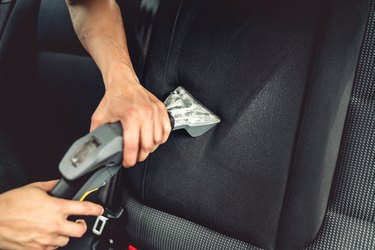Keeping suede items presentable can be challenging thanks to the fabric's delicate nature. Generally made from pig, cow or doe hide, suede can scuff easily and be difficult to clean. As a result, it's generally best to have suede professionally cleaned by experienced dry cleaners. However, you can try spot cleaning for removal of small stains with a few items you probably already have around the house. Always follow care label instructions, and test whatever method you use on a hidden area to make sure it won't cause discoloration or further staining.

Video of the Day
The Best Suede Care is Prevention
Proper storage is important for suede that's not in use. Protect the fabric by storing in a dark, dry environment. Never store suede in plastic. Rather, place the item in a cloth bag or pillowcase. Don't use newspaper, as the ink may leach into the fabric and cause discoloration.
Video of the Day
Avoid wearing suede clothing and accessories on overcast or rainy days, since water can permanently stain suede even if the manufacturer labels the item water- or stain-proof. Hot and humid summer weather can likewise damage suede.
Prevent stains from body oils, lotions, and creams by placing a lightweight layer of clothing between your skin and the suede item. Thin socks, scarves and t-shirts are especially suitable for this purpose.
Finally, apply suede protector products to help shield the fabric from water and dirt. Use a product explicitly labeled as being safe for use on suede, and follow the product instructions carefully. Use a light, all-over mist to avoid soaking any part of the item. Reapply annually to keep your suede protected year-round.
Assembling a Suede Care Kit
To care for suede fabric in your home, put together a small kit containing the following items:
- A suede brush with wire bristles on one side (for cleaning) and rubber bristles on the other (to safely raise the suede's nap)
- Clean art gum or white eraser (not the pink kind at the end of a pencil, which can cause discoloration)
- Emery boards
- Paper towels and cotton squares
- White vinegar
- Baking soda or cornstarch
- Clean white towels
Removing Dry Stains
Treat a stain on any suede item as soon after the stain occurs as possible to avoid permanent setting. First, rub the item with a clean towel or use your suede brush's rubber bristles to raise the nap and make cleaning easier. Next, use the wire bristles of your brush with short, gentle strokes to brush off the dried substance. If that fails to remove the stain, try rubbing an art gum eraser on the stain lightly. Use short, gentle, even strokes. After the substance is removed, use the suede brush again to restore the nap.
Removing Wet Stains
Wet stains require additional care. First, apply clean paper towels to the damp area to soak up as much moisture as possible. Blot gently and don't apply too much pressure in this step. Next, place the item on a flat surface, cover the affected area with clean paper towels, and place a book on top to maintain pressure. Wait for the item to dry completely before proceeding.
Once the stain is dry, dampen a clean paper towel with water, then dip the damp paper towel in white vinegar. Apply the vinegar to the stained area with alternating dabbing and rubbing motions. It's important not to soak the item in vinegar, so use a gentle touch. Once cleaned, the item may retain a slight vinegar scent but this should fade over time.
Getting Rid of Oil-Based Stains
Oil or grease-based stains can present special challenges. Start by blotting excess liquid away with paper towels, then sprinkle baking soda on the stain. Cornstarch may also work well for this purpose. Leave the item overnight. In the morning, use a steamer (or the steam function on an iron) to dampen the stain lightly, then brush the stain and baking soda away with your suede brush.
Dealing With Sticky Adhesives and Residue
Tape and sticky name tags can permanently damage suede clothes and upholstery. It's important to avoid chemical adhesive removers for these stubborn stains.
Instead, moisten the area lightly with a damp paper towel. Then use the non-serrated side of a butter knife or a credit card to loosen one corner of the sticker. Work your way underneath that corner, then gently scrape the sticker away from the suede. Make sure the item has completely dried before proceeding. Once the area is thoroughly dry, use your art gum eraser to tackle the residual sticky adhesive. Take a gentle approach. A light rub should eventually work. When the adhesive residue is gone, use the suede brush to restore the nap.
Removing Ink, Blood and Gum
Certain types of stains require a more targeted approach.
For wax or gum, place the item in your freezer for a few hours to harden the substance. You should then be able to break the substance into smaller chunks, and finally use your suede brush to remove.
Blood stains may respond well to a paper towel or cotton ball dampened with hydrogen peroxide. However, this may affect colored suede fabric, so test first on a hidden area.
For ink stains, dab the stain carefully with a paper towel. Once the stain sets, you can try rubbing alcohol with a clean paper towel or cotton ball. Nail files, white erasers and suede brush tools can also help once the stain is dried.